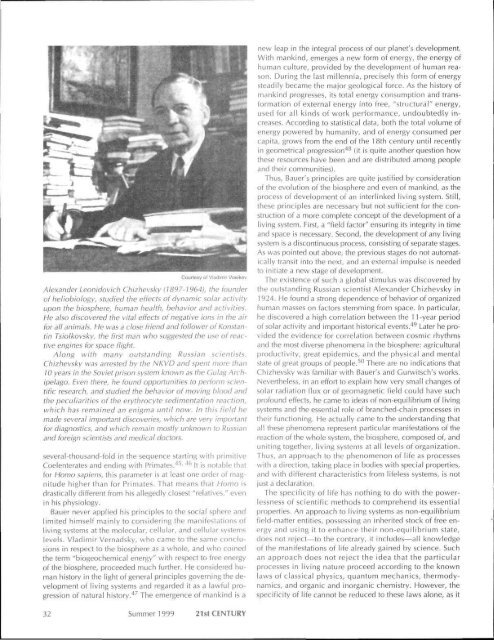Back to the Moon with Nuclear Rockets
Back to the Moon with Nuclear Rockets
Back to the Moon with Nuclear Rockets
- No tags were found...
Create successful ePaper yourself
Turn your PDF publications into a flip-book with our unique Google optimized e-Paper software.
Courtesy of Vladimir VoeikovAlexander Leonidovich Chizhevsky (1897-1964), <strong>the</strong> founderof heliobiology, studied <strong>the</strong> effects of dynamic solar activityupon <strong>the</strong> biosphere, human health, behavior and activities.He also discovered <strong>the</strong> vital effects of negative ions in <strong>the</strong> airfor all animals. He was a close friend and follower of KonstantinTsiolkovsky, <strong>the</strong> first man who suggested <strong>the</strong> use of reactiveengines for space flight.Along <strong>with</strong> many outstanding Russian scientists,Chizhevsky was arrested by <strong>the</strong> NKVD and spent more than10 years in <strong>the</strong> Soviet prison system known as <strong>the</strong> Gulag Archipelago.Even <strong>the</strong>re, he found opportunities <strong>to</strong> perform scientificresearch, and studied <strong>the</strong> behavior of moving blood and<strong>the</strong> peculiarities of <strong>the</strong> erythrocyte sedimentation reaction,which has remained an enigma until now. In this field hemade several important discoveries, which are very importantfor diagnostics, and which remain mostly unknown <strong>to</strong> Russianand foreign scientists and medical doc<strong>to</strong>rs.several-thousand-fold in <strong>the</strong> sequence starting <strong>with</strong> primitive45, 46Coelenterates and ending <strong>with</strong> Primates. It is notable thatfor Homo sapiens, this parameter is at least one order of magnitudehigher than for Primates. That means that Homo isdrastically different from his allegedly closest "relatives," evenin his physiology.Bauer never applied his principles <strong>to</strong> <strong>the</strong> social sphere andlimited himself mainly <strong>to</strong> considering <strong>the</strong> manifestations ofliving systems at <strong>the</strong> molecular, cellular, and cellular systemslevels. Vladimir Vernadsky, who came <strong>to</strong> <strong>the</strong> same conclusionsin respect <strong>to</strong> <strong>the</strong> biosphere as a whole, and who coined<strong>the</strong> term "biogeochemical energy" <strong>with</strong> respect <strong>to</strong> free energyof <strong>the</strong> biosphere, proceeded much fur<strong>the</strong>r. He considered humanhis<strong>to</strong>ry in <strong>the</strong> light of general principles governing <strong>the</strong> developmen<strong>to</strong>f living systems and regarded it as a lawful progressionof natural his<strong>to</strong>ry. 47 The emergence of mankind is anew leap in <strong>the</strong> integral process of our planet's development.With mankind, emerges a new form of energy, <strong>the</strong> energy ofhuman culture, provided by <strong>the</strong> development of human reason.During <strong>the</strong> last millennia, precisely this form of energysteadily became <strong>the</strong> major geological force. As <strong>the</strong> his<strong>to</strong>ry ofmankind progresses, its <strong>to</strong>tal energy consumption and transformationof external energy in<strong>to</strong> free, "structural" energy,used for all kinds of work performance, undoubtedly increases.According <strong>to</strong> statistical data, both <strong>the</strong> <strong>to</strong>tal volume ofenergy powered by humanity, and of energy consumed percapita, grows from <strong>the</strong> end of <strong>the</strong> 18th century until recentlyin geometrical progression 48 (it is quite ano<strong>the</strong>r question how<strong>the</strong>se resources have been and are distributed among peopleand <strong>the</strong>ir communities).Thus, Bauer's principles are quite justified by considerationof <strong>the</strong> evolution of <strong>the</strong> biosphere and even of mankind, as <strong>the</strong>process of development of an interlinked living system. Still,<strong>the</strong>se principles are necessary but not sufficient for <strong>the</strong> constructionof a more complete concept of <strong>the</strong> development of aliving system. First, a "field fac<strong>to</strong>r" ensuring its integrity in timeand space is necessary. Second, <strong>the</strong> development of any livingsystem is a discontinuous process, consisting of separate stages.As was pointed out above, <strong>the</strong> previous stages do not au<strong>to</strong>maticallytransit in<strong>to</strong> <strong>the</strong> next, and an external impulse is needed<strong>to</strong> initiate a new stage of development.The existence of such a global stimulus was discovered by<strong>the</strong> outstanding Russian scientist Alexander Chizhevsky in1924. He found a strong dependence of behavior of organizedhuman masses on fac<strong>to</strong>rs stemming from space. In particular,he discovered a high correlation between <strong>the</strong> 11-year periodof solar activity and important his<strong>to</strong>rical events. 49 Later he provided<strong>the</strong> evidence for correlation between cosmic rhythmsand <strong>the</strong> most diverse phenomena in <strong>the</strong> biosphere: agriculturalproductivity, great epidemics, and <strong>the</strong> physical and mentalstate of great groups of people. 50 There are no indications thatChizhevsky was familiar <strong>with</strong> Bauer's and Gurwitsch's works.Never<strong>the</strong>less, in an effort <strong>to</strong> explain how very small changes ofsolar radiation flux or of geomagnetic field could have suchprofound effects, he came <strong>to</strong> ideas of non-equilibrium of livingsystems and <strong>the</strong> essential role of branched-chain processes in<strong>the</strong>ir functioning. He actually came <strong>to</strong> <strong>the</strong> understanding thatall <strong>the</strong>se phenomena represent particular manifestations of <strong>the</strong>reaction of <strong>the</strong> whole system, <strong>the</strong> biosphere, composed of, anduniting <strong>to</strong>ge<strong>the</strong>r, living systems at all levels of organization.Thus, an approach <strong>to</strong> <strong>the</strong> phenomenon of life as processes<strong>with</strong> a direction, taking place in bodies <strong>with</strong> special properties,and <strong>with</strong> different characteristics from lifeless systems, is notjust a declaration.The specificity of life has nothing <strong>to</strong> do <strong>with</strong> <strong>the</strong> powerlessnessof scientific methods <strong>to</strong> comprehend its essentialproperties. An approach <strong>to</strong> living systems as non-equilibriumfield-matter entities, possessing an inherited s<strong>to</strong>ck of free energyand using it <strong>to</strong> enhance <strong>the</strong>ir non-equilibrium state,does not reject—<strong>to</strong> <strong>the</strong> contrary, it includes—all knowledgeof <strong>the</strong> manifestations of life already gained by science. Suchan approach does not reject <strong>the</strong> idea that <strong>the</strong> particularprocesses in living nature proceed according <strong>to</strong> <strong>the</strong> knownlaws of classical physics, quantum mechanics, <strong>the</strong>rmodynamics,and organic and inorganic chemistry. However, <strong>the</strong>specificity of life cannot be reduced <strong>to</strong> <strong>the</strong>se laws alone, as it32 Summer 1999 21st CENTURY
















